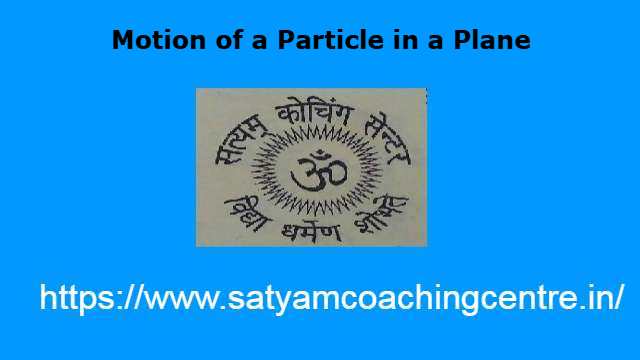Motion of a Particle in a Plane
1.समतल में कण की गति (Motion of a Particle in a Plane),गति विज्ञान में वेग एवं त्वरण (Velocity and Acceleration in Dynamics):
समतल में कण की गति (Motion of a Particle in a Plane) के इस आर्टिकल में वेग एवं त्वरण पर आधारित सवालों को हल करके समझने का प्रयास करेंगे।
आपको यह जानकारी रोचक व ज्ञानवर्धक लगे तो अपने मित्रों के साथ इस गणित के आर्टिकल को शेयर करें।यदि आप इस वेबसाइट पर पहली बार आए हैं तो वेबसाइट को फॉलो करें और ईमेल सब्सक्रिप्शन को भी फॉलो करें।जिससे नए आर्टिकल का नोटिफिकेशन आपको मिल सके।यदि आर्टिकल पसन्द आए तो अपने मित्रों के साथ शेयर और लाईक करें जिससे वे भी लाभ उठाए।आपकी कोई समस्या हो या कोई सुझाव देना चाहते हैं तो कमेंट करके बताएं।इस आर्टिकल को पूरा पढ़ें।
Also Read This Article:- Velocity and Acceleration in Dynamics
2.समतल में कण की गति के उदाहरण (Motion of a Particle in a Plane Illustrations):
Illustration:1.एक समतल में गतिमान कण के t समय पर निर्देशांक x=a(2 t+\sin 2 t), y=a(1-\cos 2 t) है।सिद्ध करो कि उसका त्वरण अचर रहता है तथा t समय पर उसकी गति की दिशा भी ज्ञात करो।
(The coordinates of a moving point in a plane at time t are given by x=a(2 t+\sin 2 t), y=a(1-\cos 2 t) . Prove that its acceleration is constant.Find also the direction of motion at time t.)
Solution: x=a(2 t+\sin 2 t), y=a(1-\cos 2 t)
t के सापेक्ष अवकलन करने परः
\frac{d x}{d t}=2 a+2 a \cos 2 t, \frac{d y}{d x}=2 a \sin 2 t
पुनः t के सापेक्ष अवकलन करने परः
\frac{d^2 x}{d t^2}=-4 a \sin 2 t, \frac{d^2 y}{d t^2}=4 a \cos 2 t
कण का त्वरण=\sqrt{\left(\frac{d^2 x}{d t^2}\right)^2+\left(\frac{d^2 y}{d t^2}\right)^2} \\ =\sqrt{(-4 a \sin 2 t)^2+(4 a \cos 2 t)^2} \\ =\sqrt{16 a^2 \sin ^2 2 t+16 a^2 \cos ^2 2 t} \\ =\sqrt{16 a^2\left(\sin ^2 2 t+\cos ^2 2 t\right)} \\ =\sqrt{16 a^2} \\ =4 a
जो कि अचर है।
\tan \theta=\frac{\frac{d y}{d t}}{\frac{d x}{d t}} \\ =\frac{2 a \sin 2 t}{2 a+2 a \cos 2 t} \\ =\frac{2 a \times 2 \sin t \cos t}{2 a(1+\cos 2 t)} \\ =\frac{2 \sin t \cos t}{1+2 \cos ^2 t-1} \\ =\frac{2 \sin t \cos t}{2 \cos ^2 t} \\ \Rightarrow \tan \theta =\tan t \\ \Rightarrow \theta =t (x-अक्ष के साथ)
Illustration:2.यदि किसी गतिमान बिन्दु की t समय पर स्थिति x=a \cos t, y=a \sin t से दी जाये तो इसका वेग,त्वरण एवं पथ ज्ञात कीजिए।
(If the position of a moving point at time t is given by x=a \cos t, y=a \sin t ;find its velocity,acceleration and path.)
Solution: x=a \cos t, y=a \sin t \cdots(1)
बिन्दुपथ ज्ञात करने के लिए t का विलोपन करने परः
x^2+y^2 =a^2 \cos ^2 t+a^2 \sin ^2 t \\ \Rightarrow x^2+y^2 =a^2\left(\cos ^2 t+\sin ^2 t\right) \\ \Rightarrow x^2+y^2=a^2
t के सापेक्ष अवकलन करने परः
\frac{d x}{d t}=-a \sin t, \frac{d y}{d t}=a \cos t
पुनः t के सापेक्ष अवकलन करने परः
\frac{d^2 x}{d t^2}=-a \cos t, \frac{d^2 y}{d t^2}=-a \sin t
बिन्दु का वेग (velocity)=\sqrt{\left(\frac{d x}{d t}\right)^2+\left(\frac{d y}{d t}\right)^2} \\=\sqrt{(-a \sin t)^2+(a \cos t)^2} \\ =\sqrt{a^2 \sin ^2 t+a^2 \cos ^2 t} \\ =\sqrt{a^2\left(\sin ^2 t+\cos ^2 t\right)} \\ =\sqrt{a^2} \\ =a
बिन्दु का त्वरण (acceleration)=\sqrt{\left(\frac{d^2 x}{d t^2}\right)^2+\left(\frac{d^2 y}{d t^2}\right)^2} \\ =\sqrt{(-a \cos t)^2+(-a \sin t)^2} \\ =\sqrt{a^2 \cos ^2 t+a^2 \sin ^2 t} \\ =\sqrt{a^2\left(\cos ^2 t+\sin ^2 t\right)} \\ =\sqrt{a^2} \\ =a
Illustration:3.यदि t समय पर किसी गतिशील कण के निर्देशांक x=a \cos ^3 t , y=a \sin ^3 t हो,तो उसका पथ तथा t समय पर वेग व त्वरण ज्ञात करो।
(The coordinates of a moving particle at time t are given by x=a \cos ^3 t , y=a \sin ^3 t . Find its path,velocity and acceleration at time t.)
Solution: x=a \cos ^3 t \cdots(1) \\ y=a \sin ^3 t \cdots(2)
(1) व (2) से t का विलोपन करने परः
x^{\frac{1}{3}}=a^{\frac{1}{3}} \cos t, y^{\frac{1}{3}}=a^{\frac{1}{3}} \sin t
वर्ग करके जोड़ने परः
x^{\frac{2}{3}}+y^{\frac{2}{3}}=a^{\frac{2}{3}} \cos ^2 t+a^{\frac{2}{3}} \sin ^2 t \\ =a^{\frac{2}{3}} \left(\cos ^2 t+\sin ^2 t\right) \\ \Rightarrow x^{\frac{2}{3}}+y^{\frac{2}{3}}=a^{\frac{2}{3}}
(1) व (2) का t के सापेक्ष अवकलन करने परः
\frac{d x}{d t}=-3 a \cos ^2 t \sin t \\ \frac{d y}{d t}=3 a \sin ^2 t \cos t
पुनः t के सापेक्ष अवकलन करने परः
\frac{d^2 x}{d t^2}=-3 a \cos ^3 t+6 a \cos t \sin ^2 t \\ \frac{d^2 y}{d t^2}=-3 a \sin ^3 t+6 a \sin t \cos ^2 t
बिन्दु का वेग (velocity)=\sqrt{\left(\frac{d x}{d t}\right)^2+\left(\frac{d y}{d t}\right)^2} \\ =\sqrt{\left(-3 a \cos ^2 t \sin t\right)^2+\left(3 a \sin ^2 t \cos t\right)^2} \\ =\sqrt{9 a^2 \cos ^4 t \sin ^2 t+9 a^2 \sin ^4 \cos ^2 t} \\ =\sqrt{9 a^2 \cos ^2 t \sin ^2 t\left(\cos ^2 t+\sin ^2 t\right)} \\ =\sqrt{9 a^2 \cos ^2 t \sin ^2 t} \\ =3 a \cos t \sin t
बिन्दु का त्वरण (acceleration)=\sqrt{\left(\frac{d^2 x}{d t}\right)^2+\left(\frac{d^2 y}{d t^2}\right)^2} \\ =\sqrt{\left(-3 a \cos ^3 t+6 a \cos t \sin ^2 t\right)^2+\left(-3 a \sin ^3 t+6 a \sin ^2 t \cos ^2 t\right)^2} \\ =\sqrt{\begin{matrix} 9 a^2 \cos ^6 t+36 a^2 \cos ^2 t \sin ^4 t-36 a^2 \cos ^4 t \sin ^2 t \\ +9 a^2 \sin ^6 t+36 a^2 \sin ^2 t \cos ^4 t-36 a^2 \sin ^4 t \cos ^2 t \end{matrix}} \\ =\sqrt{9 a^2\left(\cos ^6 t+\sin ^6 t\right)} \\ =3 a \sqrt{\left(\cos ^2 t\right)^3+\left(\sin ^2 t\right)^3} \\ =3 a \sqrt{\left(\cos ^2 t+\sin ^2 t\right)\left(\cos ^4 t+\sin ^4 t-\cos ^2 t \sin ^2 t\right)} \\ =3 a \sqrt{\left(\cos ^4 t+\sin ^4 t+2 \sin ^2 t \cos ^2 t-3 \sin ^2 t \cos ^2 t\right)} \\ =3 a \sqrt{\left(\sin ^2 t+\cos ^2 t\right)^2-3 \sin ^2 t \cos ^2 t} \\ =3 a \sqrt{1-3 \sin ^2 t \cos ^2 t}
Illustration:4.एक कण XY समतल में वक्र x=3 \cos t-\cos 3 t , y=3 \sin t-\sin 3 t के अनुदिश गतिमान है,जहाँ x,y मीटर में है तथा t सेकण्ड में है। t=\frac{\pi}{6} सेकण्ड पर इसका वेग एवं त्वरण ज्ञात कीजिए।
(A particle is in motion in XY plane along the curve x=3 \cos t-\cos 3 t , y=3 \sin t-\sin 3 t ;where x,y are in meters and t in seconds.Find its velocity and acceleration at t=\frac{\pi}{6} secs.)
Solution: x=3 \cos t-\cos 3 t \cdots(1) \\ y=3 \sin t-\sin 3 t \cdots(2)
t के सापेक्ष अवकलन करने परः
\frac{d x}{d t}=-3 \sin t+3 \sin 3 t \\ \frac{d y}{d t}=3 \cos t-3 \cos 3 t
पुनः t के सापेक्ष अवकलन करने परः
\frac{d^2 x}{d t^2}=-3 \cos t+9 \cos 3 t \\ \frac{d^2 y}{d t^2}=-3 \sin t+9 \sin 3 t
बिन्दु का वेग (velocity)=\sqrt{\left(\frac{d^2 x}{d t^2}\right)^2+\left(\frac{d^2 y}{d t^2}\right)^2} \\ =\sqrt{(-3 \sin t+3 \sin 3 t)^2+(3 \cos t-3 \cos 3 t)^2} \\ =\sqrt{\begin{matrix} (9 \sin ^2 t+9 \sin ^2 3 t-18 \sin t \sin 3 t \\ +9 \cos ^2 t+9 \cos ^2 3 t-18 \cos t \cos 3 t) \end{matrix}} \\ =\sqrt{\begin{matrix} 9[\left(\sin ^2 t+\cos ^2 t\right)+\left(\sin ^2 3 t+\cos^2 3 t\right) \\-2\left(\sin t \sin 3 t+\cos t \cos 3 t\right)]\end{matrix}}\\ =3 \sqrt{(1+1-2 \cos 2 t)} =3 \sqrt{2-2 \cos 2 t} \\ =3 \sqrt{2-2 \cos 2 \times \frac{\pi}{6}} \quad\left[t=\frac{\pi}{6}\right] \\ =3 \sqrt{\left(2-2 \cos \frac{\pi}{3}\right)} \\ =3 \sqrt{2-2 \times \frac{1}{2}} \\ =3 \sqrt{2-1} \\ =3 m/sec.
\left(\frac{d^2 x}{d t^2}\right)_{\left(t=\frac{\pi}{6}\right)}=-3 \cos \frac{\pi}{6}+9 \cos \left(\frac{3 \times \pi}{6}\right) \\ =-3 \times \frac{\sqrt{3}}{2}+9 \cos \frac{\pi}{2} \\ \Rightarrow\left(\frac{d^2 x}{d t^2}\right)_{\left(t=\frac{\pi}{6}\right)} =-\frac{3 \sqrt{3}}{2} \\ \left(\frac{d^2 y}{d t^2} \right)_{\left(t= \frac{\pi}{6}\right)} =-3 \sin \frac{\pi}{6}+9 \sin \left(3 \times \frac{\pi}{6}\right) \left[ \because t=\frac{\pi}{6}\right] \\ =-3 \times \frac{1}{2}+9 \sin \frac{\pi}{2} \\ =-\frac{3}{2}+9 \times 1 \\ =-\frac{3+18}{2} \\ \Rightarrow \left(\frac{d^2 y}{dt^2}\right)=\frac{15}{2}
बिन्दु का त्वरण (acceleration)=\sqrt{\left(\frac{d^2 x}{d t^2}\right)^2+\left(\frac{d^2 y}{d t^2}\right)^2} \\ =\sqrt{\left(-\frac{3 \sqrt{3}}{2}\right)^2+\left(\frac{15}{2}\right)^2} \\ =\sqrt{\frac{27}{4}+\frac{225}{4}} \\ =\sqrt{\frac{252}{4}} \\ =\sqrt{63} \approx 7.937 \\ \approx 7.94 \mathrm{~m} / \mathrm{sec}^2
Illustration:5.एक कण पर \mu \bar{y}^2 त्वरण (सदैव x-अक्ष की ओर) उत्पन्न करने वाला बल y-अक्ष की दिशा में क्रियाशील है।यदि कण x-अक्ष के समान्तर एक ऐसे बिन्दु से जहाँ y=a हो, \sqrt{\frac{2 \mu}{a}} वेग से फेंका जावे,तो सिद्ध करो कि उसका पथ एक चक्रज होगा।
(A particle is acted on by a force parallel to the axis of y whose acceleration (always towards the axis of x) is \mu \bar{y}^2 and is initially projected with a velocity \sqrt{\frac{2 \mu}{a}} parallel to the axis of x at the point where y=a. Prove that it will describe a cycloid.)
Solution:- \frac{d^2 y}{d t^2}=-\frac{\mu}{y^2} [ऋणात्मक चिन्ह x-अक्ष की दिशा की ओर प्रदर्शित करता है]
\Rightarrow v \frac{d v}{d y}=-\frac{\mu}{y^2} \\ \Rightarrow v d v=-\frac{\mu}{y^2} d y
समाकलन करने परः
\int v d v=-\int \frac{\mu}{y^2} d y \\ \Rightarrow \frac{v^2}{2}=\frac{\mu}{y}+C
प्रारम्भ में जब y=a तो v=0
0 =\frac{\mu}{a}+C \Rightarrow c=-\frac{\mu}{a} \\ \frac{V^2}{2} =\frac{\mu}{y}-\frac{\mu}{a} \\ \Rightarrow \nu^2 =2 \mu \left(\frac{1}{y}-\frac{1}{a}\right) \\ \Rightarrow \nu^2 =\frac{2 \mu}{a}\left(\frac{a-y}{y}\right) \\ \Rightarrow v=\frac{d v}{d t}=-\sqrt{\frac{2 \mu}{a}} \sqrt{\frac{a-y}{y}} \cdots(1)
x-अक्ष के समान्तर त्वरण
\frac{d^2 x}{d t^2}=0 \\ \frac{d x}{d t}=k
प्रारम्भ में \frac{d x}{d t}=\sqrt{\frac{2 \mu}{a}} \cdots(2)
(1) में (2) का भाग देने पर:
\frac{\frac{d y}{d t}}{\frac{d x}{d t}}=\frac{-\sqrt{\frac{2 \mu}{a}} \sqrt{\frac{a-y}{y}}}{\sqrt{\frac{2 \mu}{a}}} \\ \Rightarrow \frac{d y}{d x}=-\sqrt{\frac{a-y}{a}} \\ \Rightarrow \int d x=-\int \sqrt{\frac{y}{a-y} d y}
put y=a \cos ^2 \theta \Rightarrow y=\frac{a}{2}(1+\cos 2 \theta) \cdots(3) \\ dy=\frac{a}{2} \cdot(-2 \sin 2 \theta) d \theta \\ \Rightarrow d y=-a \sin 2 \theta d \theta \\ x=\int d x=-\int \sqrt{\frac{\frac{a}{2}(1+\cos 2 \theta)}{a-\frac{a}{2}(1+\cos 2 \theta)}} \times -a \sin 2 \theta d \theta \\ =\int \sqrt{\frac{(1+ \cos 2 \theta)}{(1-\cos 2 \theta)}} \times a \sin 2 \theta d \theta \\ =\int \frac{\cos \theta}{\sin \theta} \times 2 a \sin \theta \cos \theta d \theta \\ =2 a \int \cos ^2 \theta d \theta d \theta \\ =a \int\left(\frac{1 +\cos 2 \theta}{2}\right) d \theta \\ \Rightarrow x=\frac{a}{2}\left(\theta+\frac{\sin 2 \theta}{2}\right) +c_1
प्रारम्भ में x=0,y=a
a=\frac{a}{2}(1+\cos 2 \theta) \\ \Rightarrow 2=1+\cos 2 \theta \\ \Rightarrow \cos 2 \theta=1 \Rightarrow \cos 2 \theta=\cos 0 \\ \Rightarrow \theta=0 \\ c_1=0 \\ x=\frac{a}{2}\left(\theta+\frac{\sin 2 \theta}{2}\right) \cdots(4)
(3) व (4) सेः
x=A(t+\sin t) जहाँ A=\frac{a}{2}, t=2 \theta \\ y=A(1+\cos t)
Illustration:6.एक कण y-अक्ष के समान्तर अचर वेग से गतिशील है तथा x-अक्ष के समान्तर वेग y के समानुपाती है।सिद्ध करो कि उसका पथ एक परवलय होगा।
(A particle is moving with a constant velocity parallel to the axis of y and a velocity proportional to y parallel to the axis of x.Prove that it will describe a parabola.)
Solution: \frac{d y}{d t}= k, \frac{d x}{d t}=c y\\ \frac{\frac{d y}{d t}}{\frac{d x}{d t}}=\frac{k}{c y} \\ \Rightarrow \frac{d y}{d x}=\frac{k}{c y} \\ y dy=\frac{k}{c} dx
समाकलन करने परः
\int y dy=\frac{k}{c} \int d x \\ \Rightarrow y^2=\frac{k}{c} x \\ \Rightarrow y^2=4ax \left[ \because 4a=\frac{k}{a} \right]
जो कि परवलय का समीकरण है।
Illustration:7.एक परवलय y^2=4ax पर गतिमान है।सिद्ध करो कि (i)यदि इसका उर्ध्वाधर वेग अचर हो,तो इसके कोटि का पाद का त्वरण अचर होगा,(ii)यदि इसका क्षैतिज वेग अचर हो,तो उसका उर्ध्वाधर वेग इसके कोटि के व्युत्क्रमानुपाती होगा,(iii)यदि इनका वेग अचर हो,तो कोटि के पाद का त्वरण नियता से दूरी के वर्ग का व्युत्क्रमानुपाती होगा।
(A particle describes a parabola y^2=4ax . Prove that (i)if its vertical velocity is constant,then acceleration of the foot of its ordinate is constant, (ii)if its horizontal velocity is constant,then its vertical velocity is inversely proportional to its ordinate, (iii)if its velocity is constant, then the acceleration of the foot of the ordinate is inversely proportional to the square of the distance from the directix.)
Solution:- y^2=4 a x
दोनों पक्षों का t के सापेक्ष अवकलन करने परः
2 y \frac{d y}{d t}=4 a \frac{d x}{d t} \\ \Rightarrow y \frac{d y}{d t}=2 a \frac{d x}{d t} \cdots(1)
(i)यदि \frac{d y}{d t}=k
(1) सेः ky=2 a \frac{d x}{d t}
पुनः t के सापेक्ष अवकलन करने परः
k \frac{d y}{d t}=2 a \frac{d^2 x}{d t^2} \\ \Rightarrow \frac{d^2 x}{d t^2}=k \cdot k \\ \Rightarrow \frac{d^2 x}{d t^2}=k^2= constant
(ii)यदि \frac{d x}{d t}=k तो (1) सेः
y \frac{d y}{d t}=2 a c \\ \Rightarrow \frac{d y}{d t}=\frac{2 a c}{y} \\ \frac{d y}{d t} \propto \frac{1}{y}
(iii) यदि \sqrt{\left(\frac{d x}{d t}\right)^2+\left(\frac{d y}{d t}\right)^2}=A \\ \Rightarrow\left(\frac{d x}{d t}\right)^2+\left(\frac{d y}{d t}\right)^2=A^2 \cdots(2)
\left(\frac{d y}{d t}\right) का मान समीकरण (1) से (2) में रखने परः
\left(\frac{d x}{d t}\right)^2+\left(\frac{2 a}{y} \frac{d x}{d t}\right)^2=A^2 \\ \left(\frac{d x}{d t}\right)^2\left[1+\frac{4 a^2}{y^2}\right]=A^2 \\ \left(\frac{d x}{d t}\right)^2\left[1+\frac{4 a^2}{4 a x}\right]=A^2 \quad\left[\because y^2=4 a x\right] \\ \left(\frac{d x}{d t}\right)^2\left(1+\frac{a}{x}\right)=A^2 \cdots(3) \\ \Rightarrow \frac{d x}{d t} \sqrt{1+\frac{a}{x}}=A
पुनः t के सापेक्ष अवकलन करने परः
\frac{d^2 x}{d t^2} \sqrt{1+\frac{a}{x}}+\frac{d x}{d t} \cdot \frac{1}{2 \sqrt{1+\frac{a}{x}}} \cdot\left(-\frac{a}{x^2}\right) \frac{d x}{d t}=0 \\ \Rightarrow \frac{d^2 x}{d t^2} \sqrt{1+\frac{a}{x}}=\frac{a}{2\left(\sqrt{1+\frac{a}{x}}\right)\left(x^2\right)}\left(\frac{d x}{d t}\right)^2 \\ \Rightarrow \frac{d^2 x}{d t^2} 2\left(1+\frac{a}{x}\right)=\frac{a}{x^2}\left(\frac{d x}{d t}\right)^2 \\ \Rightarrow \frac{d^2 x}{d t^2} 2\left(1+\frac{a}{x}\right)=\frac{a}{x^2} \cdot \frac{A^2}{\left(1+\frac{a}{x}\right)} [(3) से]
\Rightarrow \frac{d^2 x}{d t^2} 2\left(1+\frac{a}{x}\right)=\frac{A^2 a}{\left(x^2+a x\right)} \\ \Rightarrow \frac{d^2 x}{d t^2} \frac{2(x+a)}{x}=\frac{A^2 a}{x(x+a)} \\ \Rightarrow \frac{d^2 x}{d t^2}=\frac{A^2 a}{2(x+a)^2} \\ \Rightarrow \frac{d^2 x}{d t^2} \propto \frac{1}{(x+a)^2}
उपर्युक्त उदाहरणों के द्वारा समतल में कण की गति (Motion of a Particle in a Plane),गति विज्ञान में वेग एवं त्वरण (Velocity and Acceleration in Dynamics) को समझ सकते हैं।
3.समतल में कण की गति के सवाल (Motion of a Particle in a Plane Questions):
(1.)यदि t समय पर गतिशील बिन्दु के निर्देशांक x=a t^2, y=2 a t हो,तो उसका परिणामी वेग और त्वरण का परिणाम व दिशा ज्ञात करो।
(The coordinates of a moving point at time t are given by x=a t^2, y=2 a t . Find the magnitude and direction of its resultant.)
(2.)एक कण पर \lambda y त्वरण उत्पन्न करने वाला बल y-अक्ष की दिशा में क्रियाशील है।यदि कण x-अक्ष के समान्तर एक ऐसे बिन्दु से जहाँ y=a हो, a \sqrt{\lambda} वेग से फेंका जाए,सिद्ध करो कि उसका पथ एक कैटिनरी होगा।
(A particle is acted on by a force parallel to the axis of y whose acceleration is \lambda y , and is initially projected with a velocity a \sqrt{\lambda} parallel to the axis of x at a point where y=a. Prove that it will describe a catenary.)
उत्तर (Answers):(1.)वेग=2 a \sqrt{\left(1+t^2\right)} ,x-अक्ष के साथ कोण=\tan ^{-1}\left(\frac{1}{t}\right) ,x-अक्ष के लम्बवत त्वरण=2a
(2.) y=a \cosh \left(\frac{x}{a}\right) उपर्युक्त सवालों को हल करने पर समतल में कण की गति (Motion of a Particle in a Plane),गति विज्ञान में वेग एवं त्वरण (Velocity and Acceleration in Dynamics) को ठीक से समझ सकते हैं।
Also Read This Article:- Vertical Motion Under Gravity
4.समतल में कण की गति (Frequently Asked Questions Related to Motion of a Particle in a Plane),गति विज्ञान में वेग एवं त्वरण (Velocity and Acceleration in Dynamics) से सम्बन्धित अक्सर पूछे जाने वाले प्रश्न:
प्रश्न:1.वेग एवं त्वरण के घटक से क्या आशय है? (What Do You Mean by Components of Velocity and Acceleration?):
उत्तर:जब एक कण किसी समतल में गतिशील हो तब सामान्यतः इसका गतिपथ एक वक्र होता है।इसका वेग तथा त्वरण को सुविधानुसार चुनी हुई किन्हीं दो दिशाओं में वियोजित (resolving) कर,जो कि सामान्यतः एक दूसरे से लम्बवत होती है,पूर्ण रूप से ज्ञात किया जा सकता है।दो लम्बवत दिशाओं में वेग तथा त्वरण के वियोजित भागों को इनके घटक (components) कहते हैं।
प्रश्न:2.निर्देशाक्षों के समान्तर वेग के घटक बताइए। (Describe the Components of Velocity Parallel to Co-ordinate Axes):
उत्तर:(1.)x-अक्ष के समान्तर वेग का घटक
v_x=\frac{d x}{d t}=\dot{x}
(2.)y-अक्ष के समान्तर वेग का घटक
v_y=\frac{d y}{d t}=\dot{y}
प्रश्न:3.निर्देशाक्षों के समान्तर त्वरण के घटक बताइए। (Describe the Components of Acceleration Parallel to Axes):
उत्तर:(1.)x-अक्ष के समान्तर त्वरण का घटक
f_x=\frac{d^2 x}{d t^2}=\ddot{x} या u \frac{d u}{d x}
(2.)y-अक्ष के समान्तर त्वरण का घटक
f_y=\frac{d^2 y}{d t^2}=\ddot{y} या v \frac{d v}{d y}
(3.)परिणामी त्वरण
f=\sqrt{f_x^2+f_y^2}=\sqrt{\ddot{x}^2+\ddot{y}^2}
(4.)यदि परिणामी वेग की दिशा x-अक्ष के साथ \theta कोण बनाए,तो
\tan \theta=\frac{\dot{y}}{\dot{x}}=\frac{d y}{d x}
(5.)यदि परिणामी त्वरण की दिशा x-अक्ष के साथ \phi कोण बनाये,तब
\tan \phi=-\frac{\ddot{y}}{\ddot{x}}
उपर्युक्त प्रश्नों के उत्तर द्वारा समतल में कण की गति (Motion of a Particle in a Plane),गति विज्ञान में वेग एवं त्वरण (Velocity and Acceleration in Dynamics) के बारे में और अधिक जानकारी प्राप्त कर सकते हैं।
| No. | Social Media | Url |
|---|---|---|
| 1. | click here | |
| 2. | you tube | click here |
| 3. | click here | |
| 4. | click here | |
| 5. | Facebook Page | click here |
| 6. | click here | |
| 7. | click here |
Motion of a Particle in a Plane
समतल में कण की गति
(Motion of a Particle in a Plane)
Motion of a Particle in a Plane
समतल में कण की गति (Motion of a Particle in a Plane) के इस आर्टिकल में वेग
एवं त्वरण पर आधारित सवालों को हल करके समझने का प्रयास करेंगे।
Related Posts
About Author
Satyam
About my self I am owner of Mathematics Satyam website.I am satya narain kumawat from manoharpur district-jaipur (Rajasthan) India pin code-303104.My qualification -B.SC. B.ed. I have read about m.sc. books,psychology,philosophy,spiritual, vedic,religious,yoga,health and different many knowledgeable books.I have about 15 years teaching experience upto M.sc. ,M.com.,English and science.








